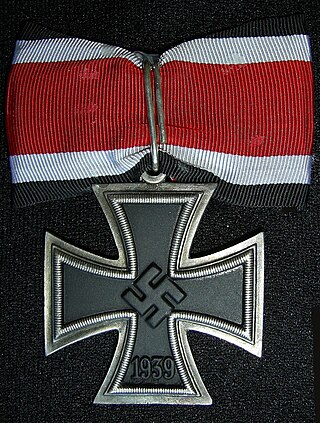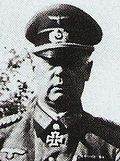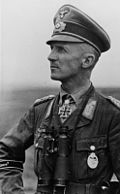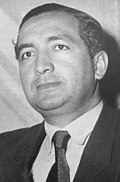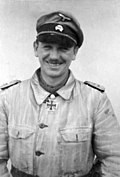Top Qs
Timeline
Chat
Perspective
List of Knight's Cross of the Iron Cross recipients (M)
From Wikipedia, the free encyclopedia
Remove ads
The Knight's Cross of the Iron Cross (German: Ritterkreuz des Eisernen Kreuzes) and its variants were the highest awards in the military and paramilitary forces of Nazi Germany during World War II. The Knight's Cross of the Iron Cross was awarded for a wide range of reasons and across all ranks, from a senior commander for skilled leadership of his troops in battle to a low-ranking soldier for a single act of extreme gallantry.[1] A total of 7,321 awards were made between its first presentation on 30 September 1939 and its last bestowal on 17 June 1945.[Note 1] This number is based on the analysis and acceptance of the order commission of the Association of Knight's Cross Recipients (AKCR). Presentations were made to members of the three military branches of the Wehrmacht—the Heer (Army), Kriegsmarine (Navy) and Luftwaffe (Air Force)—as well as the Waffen-SS, the Reichsarbeitsdienst (RAD—Reich Labour Service) and the Volkssturm (German national militia). There were also 43 recipients in the military forces of allies of the Third Reich.[3]
These recipients are listed in the 1986 edition of Walther-Peer Fellgiebel's book, Die Träger des Ritterkreuzes des Eisernen Kreuzes 1939–1945 — The Bearers of the Knight's Cross of the Iron Cross 1939–1945. Fellgiebel was the former chairman and head of the order commission of the AKCR. In 1996, the second edition of this book was published with an addendum delisting 11 of these original recipients. Author Veit Scherzer has cast doubt on a further 193 of these listings. The majority of the disputed recipients had received the award in 1945, when the deteriorating situation of Germany in the final days of World War II in Europe left a number of nominations incomplete and pending in various stages of the approval process.[4]
Listed here are the 118 Knight's Cross recipients of the Wehrmacht and Waffen-SS whose last name starts with "M".[5][Note 2] Fellgiebel himself delisted one and Scherzer has challenged the validity of seven more of these listings.[6][7] The recipients are ordered alphabetically by last name. The rank listed is the recipient's rank at the time the Knight's Cross was awarded.
Remove ads
Background
Summarize
Perspective
The Knight's Cross of the Iron Cross and its higher grades were based on four separate enactments. The first enactment, Reichsgesetzblatt I S. 1573 of 1 September 1939 instituted the Iron Cross (Eisernes Kreuz), the Knight's Cross of the Iron Cross and the Grand Cross of the Iron Cross (Großkreuz des Eisernen Kreuzes). Article 2 of the enactment mandated that the award of a higher class be preceded by the award of all preceding classes.[8] As the war progressed, some of the recipients of the Knight's Cross distinguished themselves further and a higher grade, the Knight's Cross of the Iron Cross with Oak Leaves (Ritterkreuz des Eisernen Kreuzes mit Eichenlaub), was instituted. The Oak Leaves, as they were commonly referred to, were based on the enactment Reichsgesetzblatt I S. 849 of 3 June 1940.[9] In 1941, two higher grades of the Knight's Cross were instituted. The enactment Reichsgesetzblatt I S. 613 of 28 September 1941 introduced the Knight's Cross of the Iron Cross with Oak Leaves and Swords (Ritterkreuz des Eisernen Kreuzes mit Eichenlaub und Schwertern) and the Knight's Cross of the Iron Cross with Oak Leaves, Swords and Diamonds (Ritterkreuz des Eisernen Kreuzes mit Eichenlaub, Schwertern und Brillanten).[10] At the end of 1944 the final grade, the Knight's Cross of the Iron Cross with Golden Oak Leaves, Swords, and Diamonds (Ritterkreuz des Eisernen Kreuzes mit goldenem Eichenlaub, Schwertern und Brillanten), based on the enactment Reichsgesetzblatt 1945 I S. 11 of 29 December 1944, became the final variant of the Knight's Cross authorized.[11]
Remove ads
Recipients
Summarize
Perspective
The Oberkommando der Wehrmacht (Supreme Command of the Armed Forces) kept separate Knight's Cross lists for the Heer (Army), Kriegsmarine (Navy), Luftwaffe (Air Force) and Waffen-SS. Within each of these lists a unique sequential number was assigned to each recipient. The same numbering paradigm was applied to the higher grades of the Knight's Cross, one list per grade.[12] Of the 457 awards made to servicemen whose last name starts with "M", 46 were later awarded the Knight's Cross of the Iron Cross with Oak Leaves, nine the Knight's Cross of the Iron Cross with Oak Leaves and Swords and five the Knight's Cross of the Iron Cross with Oak Leaves, Swords and Diamonds; 29 presentations were made posthumously. Heer members received 293 of the medals; 29 went to the Kriegsmarine, 113 to the Luftwaffe, and 22 to the Waffen-SS.[5] The sequential numbers greater than 843 for the Knight's Cross of the Iron Cross with Oak Leaves and 143 for the Knight's Cross of the Iron Cross with Oak Leaves and Swords are unofficial and were assigned by the Association of Knight's Cross Recipients (AKCR) and are therefore denoted in parentheses.[13]
This along with the + (plus) indicates that a higher grade of Knight's Cross was awarded as well.
This along with the * (asterisk) indicates that the Knight's Cross was awarded posthumously.
This along with the ! (exclamation mark) indicates that author Walther-Peer Fellgiebel has expressed doubt regarding the veracity and formal correctness of the listing.
This along with the ? (question mark) indicates that author Veit Scherzer has expressed doubt regarding the veracity and formal correctness of the listing.
Remove ads
Notes
- Großadmiral and President of Germany Karl Dönitz, Hitler's successor as Head of State (Staatsoberhaupt) and Supreme Commander of the Armed Forces, had ordered the cessation of all promotions and awards as of 11 May 1945 (Dönitz-decree). Consequently the last Knight's Cross awarded to Oberleutnant zur See of the Reserves Georg-Wolfgang Feller on 17 June 1945 must therefore be considered a de facto but not de jure hand-out.[2]
- Erich von Lewinski called Erich von Manstein is not counted here. He is counted among the 386 recipients whose last name starts with "L" (see List of Knight's Cross of the Iron Cross recipients (L)).
- For an explanation of the various naming schemes used by the Luftwaffe, Heer, Kriegsmarine and Waffen-SS refer to nomenclature used by the Wehrmacht and Waffen-SS.
- Robert Macher received confirmation of the Knight's Cross of the Iron Cross presentation via radio transmission from the Dönitz Government to Armeeoberkommando Ostpreußen (AOK Ostpreußen—Army High Command East Prussia) on 14 May 1945 according to Walther-Peer Fellgiebel. The AOK was still reachable until 12:00 noon on this day. This presentation is considered a direct presentation. There is no record of this presentation in the Heerespersonalamt (HPA —Army Staff Office). This presentation is void since it was made after 8 May 1945.[17]
- According to Scherzer as pilot in the I./Jagdgeschwader 2 "Richthofen".[18]
- According to Scherzer as pilot and observer in Aufklärungs-Gruppe 11.[18]
- According to Scherzer as Staffelkapitän of the Aufklärungsstaffel 1.(F)/33.[19]
- According to Scherzer as pilot in the III./Kampfgeschwader 2.[19]
- According to Scherzer as pilot and observer in the I./Kampfgeschwader 4 "General Wever".[22]
- According to Scherzer as commander of Schützen-Regiment 104 and leader of a Kampfgruppe in Panzer Armee Afrika.[28]
- The brackets around the doctor title [Dr.] denotes that the academic title was attained after the Knight's Cross of the Iron Cross was awarded.
- According to Scherzer as Oberfeldwebel.[28]
- According to Scherzer as Oberleutnant of the Reserves.[28]
- According to Scherzer as leader Aufklärungs-Abteilung of the "Totenkopf"-Division.[32]
- No evidence of the award can be found in the German Federal Archives. Von Seemen listed Siegmund Matheja in his second edition and noted: "No evidence in the German Federal Archives, see history of "Großdeutschland" division".[34] The history describes the battles at Bisamberg near Korneuburg mid April 1945 briefly. Here Matheja presumably destroyed six enemy tanks, Matheja and his actions however are not described in the division's history. The order commission of the Association of Knight's Cross Recipients (AKCR) processed this case in 1981 and decided "Knight's Cross yes, 6 May 1945". The presentation date is an assumption of the AKCR. Unfortunately Matheja, a member of the AKCR, himself did nothing to help clarify the situation. Twice he failed to respond to a letter (24 July and 22 August 2004) from the chairman of the AKCR.[35]
- According to Scherzer as Gruppenkommandeur of the I./Jagdgeschwader 2 "Richthofen".[36]
- According to Scherzer as leader of a Kampfgruppe in Verteidigungs-Abschnitt "A" (defensive sector "A").[36]
- No evidence of the award can be found in the German Federal Archives.[34] The award was unlawfully presented by SS-Oberstgruppenführer Sepp Dietrich. The date is taken from the announcement made by the 6. SS-Panzerarmee.[35]
- According to Scherzer as Leutnant and pilot in the III./Jagdgeschwader 2 "Richthofen".[39]
- According to Scherzer as Staffelkapitän of the 2./Jagdgeschwader 3.[41]
- Hans Meier's nomination for the Oak Leaves was received by the Heerespersonalamt (HPA—Army Staff Office) from the troop on 12 April 1945 and approved by all intermittent commanding officers. No further comments or indications of approval have been noted and left unfinished by the end of the war. A non contemporary file card notes an entry date 17 March 1945 which could be the nomination date of the troop. The nomination list for the higher grades of Knight's Cross of the Iron Cross indicates an entry date 12 April 1945, no further date is listed. A comment states: "Unfinished". According to the Association of Knight's Cross Recipients (AKCR) the award was presented in accordance with the Dönitz-decree. This is illegal according to the Deutsche Dienststelle (WASt) and lacks legal justification. The sequential number "874" was assigned by the AKCR, the presentation date by Fellgiebel.[35]
- According to Scherzer as pilot in the Stab III./Schlachtgeschwader 77.[44]
- According to Scherzer as Staffelführer in the I./Jagdgeschwader 52.[44]
- According to Scherzer as leader of Sturmgeschütz-Batterie SS-Division-"Totenkopf".[44]
- Eugen Meindl's nomination by the troop was approved by each of his commanding officers. However the nomination contains no final remark on the proceedings. Oberst Nicolaus von Below, Hitler's Luftwaffe adjutant, had sent a teleprinter message to the commanding general of the Fallschirmarmee Generaloberst Kurt Student, requesting a statement for this nomination. The copy of the teleprinter message contains a note: resubmission "23 April 1945". It seems that the statement was never returned. The paperwork was not finalized by the end of the war. The Association of Knight's Cross Recipients (AKCR) claims that the award was presented in accordance with the Dönitz-decree. This is illegal according to the Deutsche Dienststelle (WASt) and lacks legal justification. The sequential number "155" was assigned by the AKCR. Fellgiebel assigned the presentation date. Meindl is mentioned on a list of the Oberbefehlshaber Nordwest for "Nominations and Bestowal of War Awards" from May 1945. This list, which was intended to be presented to Karl Dönitz, contained twelve names of pending nominations which had been submitted via the chain of command. Dönitz has never signed this list, most likely he has never even seen this list. The responsible personnel offices awarded or declined eight nominations from this list by the end of the war by, two remained unprocessed by the Heerespersonalamt (HPA—Army Staff Office) and Luftwaffenpersonalamt (LPA—Luftwaffe Staff Office) and two further were left ready for signing at the Oberkommando der Wehrmacht/Wehrmacht-Führungsstab (OKW/WFSt—Oberkommando der Wehrmacht/Wehrmacht-Führungsstab—leadership staff of the Army High Command).[47]
- According to Scherzer as leader of Sturmgruppe "Eisen" (Assault Group "Iron") in Luftlande-Sturm-Abteilung "Koch".[23]
- There is no reference of the Knight's Cross awarded to Hans-Joachim Merks in the German Federal Archives. His personal file contains a letter from 1955 by the Deutsche Dienststelle (WASt), indicating that no proof of the award exists. The date was assigned by the Association of Knight's Cross Recipients (AKCR).[47]
- According to Scherzer as Staffelkapitän of the 10.(S)/Lehrgeschwader 2.[57]
- According to Scherzer as Oberstleutnant zur Verwendung (for disposition).[57]
- Friedrich-August Meyer's Luftwaffenpersonalamt-Verleihungsvorschlag (LPA-VV—Air Force Staff Office Nomination Recommendation) Nr. 1493 was forwarded to the adjutancy of Hermann Göring on 3 March 1945. The nomination was never finalized and was left unfinished by the end of the war. A radio message was sent by the chief of the LPA on 12 May 1945 stating that Meyer, effective as of today, has been awarded the Knight's Cross and therefore an unlawful presentation. The presentation date 9 May 1945 was assigned by Walther-Peer Fellgiebel.[47]
- According to Scherzer as Staffelführer of the 8./Schlachtgeschwader 3.[59]
- According to Scherzer as pilot in the Eis-Staffel of the III./Kampfgeschwader 55.[59]
- According to Scherzer as pilot in the I./Schlachtgeschwader 2 "Immelmann".[60]
- According to Scherzer as fortress commander of the northern Gironde estuary, at the same time sea commander Gascony.[62]
- According to Scherzer as chief of Luftflotte 5 and Befehlshaber Nord (commander-in-chief north).[66]
- According to Scherzer as Oberleutnant.[66]
- According to Scherzer as commander of Schnellboot S-21.[68]
- According to Scherzer as pilot in the 3./Jagdgeschwader 54.[68]
- According to Scherzer as pilot in the I./Sturzkampfgeschwader 1, Oak Leaves on 25 April 1944.[71]
- According to Scherzer as Oberleutnant (war officer).[71]
- According to Scherzer as Commander of the III./Führer Begleit Brigade [= Grenadier-Battalion 928].[73]
- According to Scherzer as Aide-de-camp (O1) in the 15. Infanterie-Division.[73]
- The nomination was received by the Heerespersonalamt (HPA—Army Staff Office) from the troop on 28 April 1945 and approved by the Corps and by the OB West. Missing is a statement by the Army and by the Army Group (Heeresruppe). Major Joachim Domaschk decided "Oak Leaves yes" but deferred, Heeresgruppe B—the Sturmgeschütz-Brigade had already surrendered together with the Heeresgruppe B in the Ruhr Pocket. The nomination was therefore left unfinished according to AHA 44 Ziff. 572. The nomination list of the higher grade of the Knight's Cross of the Iron Cross with Oak Leaves confirms the entry of 28 March 1945. Noted here is a comment indicating "deferred". A formal presentation has not happened. The sequential number "868" was assigned by the Association of Knight's Cross Recipients (AKCR). The presentation date was assigned by Fellgiebel. Alfred Montag was a member of the AKCR.[79]
- According to Scherzer as Gruppenkommandeur of the IV.(Sturm)/Jagdgeschwader 3 "Udet".[80]
- According to Scherzer his name is Max Morche. Morche had been nominated for the Knight's Cross of the Iron Cross on 31 January 1945 via teleprinter message by the XX Army Corps. This teleprinter message is no longer available. The Heerespersonalamt Abteilung P 5/Registratur (Army Personnel Office Department P 5/Registry) received a teleprinter message on 8 February 1945 from the commander-in-chief of the Army Group North, which made reference to the former message. This second message contained the approvals of Morche's intermittent commanders, General der Infanterie Friedrich-Wilhelm Müller (4th Army) and Generaloberst Lothar Rendulic (Army Group North). Nevertheless the nomionation must have been rejected because Morche was not listed in the nomination book. Also missing are the nominations by the troop and the Heerespersonalamt-Verleihungsvorschlag (HPA-VV—Army Staff Office Nomination Recommendation), nor is there a file card. The Order Commission of the Association of Knight's Cross Recipients (AKCR) never processed Morche's case. According to the AKCR the award was presented in accordance with the Dönitz-decree. This is illegal according to the Deutsche Dienststelle (WASt) and lacks legal justification.[81]
- According to Scherzer as pilot in the I./Schlachtgeschwader 2 "Immelmann".[85]
- According to Scherzer as commander of the Panzer-Abteilung of the SS-Division "Wiking".[85]
- According to Scherzer commander of Schnellboot S-52.[87]
- According to Scherzer as pilot in the II./Schlachtgeschwader 2 "Immelmann".[89]
- According to Scherzer as Staffelkapitän of the 8./Jagdgeschwader 53 on 19 September 1941.[89]
- According to Scherzer as Staffelkapitän of the 7./Schlachtgeschwader 1.[90]
- According to Scherzer commander of Schnellboot S-52.[92]
- No evidence of the award can be found in the German Federal Archives. The files of the order commission of the Association of Knight's Cross Recipients (AKCR) indicated that Friedrich Müller-Rochholz's former divisional commander Generalmajor Hermann Schulte-Heuthaus in 1961 recalled that he had nominated five members of his division, presumably among them Müller-Rochholz, for the Knight's Cross of the Iron Cross in the timeframe mid to end-March 1945. Additionally a further intermittent commander, the former commanding general of the Panzer-Korps "Großdeutschland" General der Panzertruppe Georg Jauer, stated in 1961 that he had as a matter of principle always approved awards for distinguished officers. The nomination however has either never made it to the Heerespersonalamt (HPA—Army Staff Office), a fact already noted by Von Seemen, or had been rejected by the HPA. The HPA never created an internal approval request. Müller-Rochholz is also not listed in the book "Verliehene Ritterkreuze" (Awarded Knight Crosses). An autonomous presentation can also be ruled out because Müller-Rochholz had been nominated via the command chain. The presentation date was assigned by Walther-Peer Fellgiebel. Müller-Rochholz was a member of the AKCR.[81]
- According to Scherzer as adjutant in the III./Jagdgeschwader 26 "Schlageter".[96]
- According to Scherzer as Oberleutnant (war officer) and observer in the Aufklärungsstaffel 1.(F)/121.[96]
- According to Scherzer as leader of Panzer-Jäger-Abteilung 111 and of a Kampfgruppe.[100]
Remove ads
References
External links
Wikiwand - on
Seamless Wikipedia browsing. On steroids.
Remove ads
